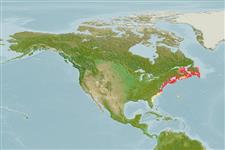Environment: milieu / climate zone / depth range / distribution range
Ecology
Marine; brackish; demersal; depth range 55 - 73 m (Ref. 5951). Temperate; 50°N - 29°N, 82°W - 52°W
Western Atlantic: Gulf of St. Lawrence in Canada to northern Florida in USA.
Length at first maturity / Size / Weight / Age
Maturity: Lm 21.9 range ? - ? cm
Max length : 45.7 cm TL male/unsexed; (Ref. 5951); max. reported age: 7 years (Ref. 1093)
Occurs from shore to 45 m depth, occasionally in deeper water.
Life cycle and mating behavior
Maturity | Reproduction | Spawning | Eggs | Fecundity | Larvae
Robins, C.R. and G.C. Ray, 1986. A field guide to Atlantic coast fishes of North America. Houghton Mifflin Company, Boston, U.S.A. 354 p. (Ref. 7251)
IUCN Red List Status (Ref. 130435: Version 2024-2)
Threat to humans
Harmless
Human uses
Fisheries: commercial
Tools
Special reports
Download XML
Internet sources
Estimates based on models
Preferred temperature (Ref.
123201): 0.9 - 10.4, mean 4.7 °C (based on 23 cells).
Phylogenetic diversity index (Ref.
82804): PD
50 = 0.5645 [Uniqueness, from 0.5 = low to 2.0 = high].
Bayesian length-weight: a=0.01023 (0.00778 - 0.01346), b=2.99 (2.92 - 3.06), in cm total length, based on LWR estimates for this species (Ref.
93245).
Trophic level (Ref.
69278): 3.7 ±0.2 se; based on diet studies.
Generation time: 4.5 ( na - na) years. Estimated as median ln(3)/K based on 2
growth studies.
Resilience (Ref.
120179): Medium, minimum population doubling time 1.4 - 4.4 years (K=0.24).
Prior r = 0.18, 95% CL = 0.12 - 0.28, Based on 2 full stock assessments.
Fishing Vulnerability (Ref.
59153): Moderate vulnerability (43 of 100).
Climate Vulnerability (Ref.
125649): High vulnerability (58 of 100).
Nutrients (Ref.
124155): Calcium = 41.4 [18.6, 70.4] mg/100g; Iron = 0.163 [0.064, 0.733] mg/100g; Protein = 18.9 [17.4, 20.4] %; Omega3 = 0.279 [0.149, 0.526] g/100g; Selenium = 11.6 [5.3, 26.2] μg/100g; VitaminA = 13.9 [3.8, 53.1] μg/100g; Zinc = 0.234 [0.136, 0.778] mg/100g (wet weight);
